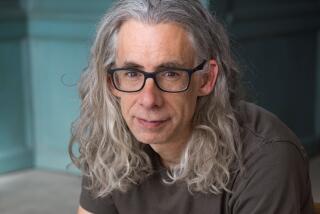Of Prowess, Peril, Rescue and Repose : IN THE SKIN OF A LION <i> by Michael Ondaatje (Alfred A. Knopf Inc.: $16.95; 244 pp.) </i>
Had socialist realism remained in the hands of the poets and been repressed and forced to go underground instead of being elevated by Stalin and enforced by his bureaucrats, we would have a recognizable lineage for âIn the Skin of a Lion.â As it is, it stands alone; lovely and strange.
If you could put the 1930s slogans and bad art out of mind and start fresh, you could think of âSkinâ as a kind of ode to the nobility of labor. Michael Ondaatjeâs novel uses the works and days of a high-steel rigger, a professional dynamiter, a dyer, a baker and a burglar as so many images of human life and prowess.
Ondaatje, a Canadian born in Ceylon to a family that had lived there for several generations, is a poet as well as a novelist. He is the author of, among other things, âRunning in the Family,â a childhood memoir that is a book of fabulousness growing out of fact. His writing attaches fantasy to reality with such a deft and hidden seam that the real seems fantastic and the fantastic real.
âSkin of a Lionâ shares this quality. Ondaatje writes of precision dynamiting or a man swinging down a steel cable so that these things are entirely material and haunted. He is laconic and numinous. A logging camp cook trudges prosaically up along the river distributing pork sandwiches and tea; then he hops on a log for the ride back downstream and suddenly he is mantled in ceremony:
âHe stood up straight in mid-river, traveling at only the speed that the river wished. He would float under the bridge without altering his posture, though there was only an inch to spare, nodding to loggers on the bank, disheartened by the ever-present crows. He would step off at the camp at Geese Island with his shoes perfectly dry.â
âSkinâ has a kinship with Doctorowâs âRagtimeâ and Mark Helprinâs âWinterâs Taleâ in that a historical and social background, more or less factual, is seeded with myth. The kinship is only formal, though; the style and spirit are original.
It is organized around a picaresque quest. The quester is Patrick Lewis, born in the Canadian north country in the early part of the century and making his life later in Toronto, which was then beginning its transition from a small to a great city. Patrickâs own transition, as he knocks about, is from seeker and observer to participant.
His search has to do with love and justice. They draw him along. But, as with all classic quest stories, most of the life is provided not by the goal but by the encounters along the way.
As a young man, Patrick is hired as one of a group of investigators trying to track Ambrose Small, a wealthy promoter who has disappeared. He meets Clara, an actress who was Smallâs lover. They have an affair; then she vanishes to rejoin Small in his hiding place. Clara is the start of Patrickâs material and moral journey; her reappearance after Smallâs death will end it.
Meanwhile, he takes up with another actress, Alice, widow of a labor organizer murdered for his activities. Alice works with a group of immigrant activists in Toronto; she dies when a bomb is mysteriously slipped into a bag she is carrying. Her death sets Patrick off on a course of political violence, which puts him in jail for a while and which he abandons after an attempt to blow up Torontoâs newly built waterworks.
The story is larger than life, and dreamier. It is full of strange and dramatic encounters, and of figures--Small, Clara, Alice, and the visionary builder of the waterworks--whose reality is heightened by myth. Ondaatjeâs complex design draws together a vivid romance, a political fable and a celebration of the wonder and harshness of constructing a modern country in a wilderness.
The story can seem arbitrary, and it can get out of hand. The shadowy figure of Small is more portentous than interesting; and there is a marginal surplus of unanchored mysteries--women, mostly--drifting in and out.
But the freshness and inventiveness of the writing overcome most of the difficulties. If the pattern is impracticably ambitious at times, the fabric is splendid.
Ondaatje gives an extraordinary sensual sheen to the brief affair between Patrick and Clara. His style is terse, with an unsettling alternation of the allusive and the direct that churns up a powerful current of tension. Indeed, the electricity produced in the few early pages devoted to Clara manages to get stored, somehow, and after everything else that happens, reappears at the end and lights it up.
But the bookâs special strength and delight lie in the exuberant but wonderfully controlled poetry of Ondaatjeâs workers. There is Patrickâs father, a burly farmer who, while topping trees, is suddenly seized by an explosive vision. An ax is nothing compared to dynamite. He buys supplies and practices in the woods until he can shift a log precisely the distance he wants. The lumber companies hire him to clear log jams and Patrick goes along as his helper. The precision, the taciturn art of the father is an equivalent to the dynamite he uses: a powerful charge in an unrevealing package. Patrickâs own outlet is calling square dances. âHe was always called on,â Ondaatje writes, âand he walked up to the stage as if it were a duty and broke into verses, swirling around the guitars and fiddles, dropping in a last phrase tight before he hit the wall of the rhyme.â
Later, in Toronto, there is Nicholas Temelcoff, a Macedonian bridge builder. He works suspended from an arch, flying down a system of pulleys and wires to bolt a girder in hard-to-reach places. He is joyfully and perilously in motion, swooping and swinging, using the wireâs tension and slack to aim himself as if he were arrow and bow at the same time.
One night, five nuns take a wrong turn from their bus stop and wander out in the dark onto the uncompleted bridge span. The wind blows one of them over the edge. Temelcoff, swinging below, grabs her in midair, dislocating his arm. They swoop down to the ground below and, in shock, help each other to the shelter of a restaurant. There they drink a little, exchange a few words, doze off over the table. With these few elements--prowess, peril, rescue, repose--Ondaatje fashions a moment of erotic tenderness that aches in its brevity.
There is Caravaggio, the burglar, whom Patrick meets in jail where he is serving time for an act of political arson he has committed in revenge for Aliceâs death. Ondaatje makes a lovely detour out of the burglarâs life: the silence he works in, the delicacy of his approach, the dog he brings along to bark if anyone comes by--a watchdog in reverse. When he comes home at night and makes love to his wife, it is like Ulysses returning to Penelope. Does this sound grandiose? It is the reader who furnishes the grandiosity, nourished and swelling out with Ondaatjeâs exhilarating detail.
Caravaggioâs escape from jail is assisted by Patrick and a friend. They are at work painting the prison roof blue. It is a blue, as they notice, indistinguishable from the sky. So they paint Caravaggio blue as well. Melting invisibly into the space around him, he departs unseen by the guards.
It is the kind of image that lights up Ondaatjeâs tale so remarkably. He places the real upon his self-invented rack and stretches it to the point where it flies apart into magic and the simple pleasure of seeing it caught in a state of unexpectedness.
More to Read
Sign up for our Book Club newsletter
Get the latest news, events and more from the Los Angeles Times Book Club, and help us get L.A. reading and talking.
You may occasionally receive promotional content from the Los Angeles Times.








